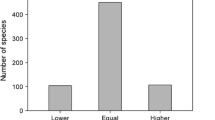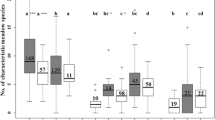Summary
Many natural populations are subdivided among partially isolated habitat patches, but the influence of habitat patchiness per se on species immigration, extinction, and the resulting patterns of species diversity, has received virtually no experimental study. In an experiment designed to test the effects of habitat subdivision on local community structure, we compare the diversity and annual turnover of flowering plant species in 3 treatments of the same total area, but subdivided to different degrees. We experimentally fragmented a California winter annual grassland into isolated plots, two of 32 m2, eight of 8 m2, and 32 of 2 m2, each treatment representing a combined area of 64 m2. Insularization of the experimental habitat fragments is provided by grazing sheep. The effects of plot area on species diversity, extinction, and turnover are consistent with the MacArthur-Wilson model. Species richness increases with the degree of habitat subdivision. Extinction, immigration, and turnover, however, are relatively independent of the degree of subdivision. These experimental results contrast with predictions that habitat subdivision necessarily results in greater rates of extinction accompanied by reduced species diversity.
Similar content being viewed by others
References
Bartolome JW (1979) Germination and seedling establishment in California annual grassland. J Ecol 67:273–281
Boeckeln WJ (1986) Optimal design of nature reserves: consequences of genetic drift. Biol Conserv 38:323–338
Caswell H (1978) Predator-mediated coexistence, a non-equilibrium model. Am Nat 112:127–154
Connor EF, McCoy ED (1979) The statistics and biology of the species-area relationship. Am Nat 113:791–833
Conover WJ (1980) Practical nonparametric statistics. Wiley, New York
Diamond JM (1971) Comparison of faunal equilibrium turnover rates on a tropical and a temperate island. Proc Natl Acad Sci USA 68:2742–2745
Diamond JM (1984) “Normal” extinction of isolated populations. In: Nitecki MH (ed) Extinctions. University of Chicago Press, Chicago, Ill, pp 191–246
Dickerson JE Jr, Robinson JV (1986) The controlled assembly of microcosmic communities: the selective extinction hypothesis. Oecologia (Berlin) 71:12–17
Forman RTT, Godron M (1986) Landscape Ecology. Wiley, New York
Gilbert LE (1980) Food web organization and the conservation of neotropical diversity. In: Soulé ME, Wilcox BA (eds) Conservation biology: an evolutionary-ecological perspective. Sinauer, Sunderland, Mass, pp 11–43
Hastings A (1978) Global stability in Lotka-Volterra systems with diffusion. J Math Biol 6:163–168
Heady HF (1958) Vegetational changes in the California annual type. Ecology 39:402–416
Heady HF (1977) Valley grassland. In: Barbour MG, Major J (eds) Terrestrial vegetation of California, Wiley, New York, pp 491–514
Huffaker CB (1958) Experimental studies on predation: dispersion factors and predator-prey interactions. Hilgardia 27:243–283
Hutchinson GE (1957) Concluding remarks. Cold Spring Harbor Symp Quant Biol 22:415–427
Jackson LE (1985) Ecological origins of California's Mediterranean grassland. J Biogeogr 12:349–361
Jain SK (1982) Variation and adaptive role of seed dormancy in some annual grasslands species. Bot Gaz 143:101–106
Janzen D (1986) The eternal external threat. In: Soulé ME (ed) Conservation biology: the science of scarcity and diversity. Sinauer, Sunderland, Mass, pp 286–303
Kareiva P (1987) Habitat fragmentation and the stability of predator-prey interactions. Nature 326:388–390
Leigh EG Jr (1981) The average lifetime of a population in a varying environment. J Theor Biol 90:213–239
Levin SA (1976) Population dynamic models in heterogeneous environments. Annu Rev Ecol Syst 7:287–310
Lovejoy TE, Rankin JM, Bierregard RO Jr, Brown KS Jr, Emmons LH, Van der Voort ME (1984) Ecosystem decay of Amazon forest remnants. In: Nitecki MH (ed) Extinctions. University of Chicago Press, Chicago, Ill, pp 295–325
Lovejoy TE, Bierregard RO Jr, Rylands AB, Malcolm JR, Quintela CE, Harper LH, Brown KS Jr, Powell AH, Powell GVN, Schubart HOR, Hays MB (1986) Edge and other effects of isolation on Amazon Forest fragments. In: Soulé ME (ed) Conservation biology: the science of scarcity and diversity. Sinauer, Sunderland, Mass, pp 257–285
Ludwig D (1976) A singular perturbation problem in the theory of population extinction. SIAM-AMS Proc 10:87–104
MacArthur RH, Wilson EO (1967) The theory of island biogeography. Princeton University Press, New York
McLellan CH, Dobson AP, Wilcove DS, Lynch JF (1986) Effects of forest fragmentation on new-and old-world bird communities: empirical observations and theoretical implications. In: Verner J, Morrison ML, Ralph CJ (eds) Wildlife 2000. University of Wisconsin Press, Madison, Wisc, pp 305–313
Moulton MP, Pimm SL (1983) The introduced Hawaiian avifauna: biogeographic evidence for competition. Am Nat 121:669–690
Munz PA, Keck DD (1968) A California flora and supplement. University of California Press, Berkeley, Calif
Newmark WD (1987) A land-bridge island perspective on mammalian extinctions in Western North American parks. Nature (London) 325:430–432
Nilsson SG (1986) Are bird communities in small biotype patches random samples from communities in large patches? Biol Conserv 38:179–204
Nilsson IN, Nilsson SG (1985) Experimental estimates of census efficiency and pseudoturnover on islands: error trend and between-observer variation when recording vascular plants. J Ecol 73:65–70
Osman RW (1978) The establishment and development of a marine epifaunal community. Ecol Monogr 47:37–63
Patterson BD, Atmar W (1986) Nested subsets and the structure of insular mammalian faunas and archipelagos. Biol J Linn Soc 28:65–82
Preston FW (1960) Time and space and the variation of species. Ecology 41:611–627
Quinn JF, Harrison SP (1987) Effects of habitat fragmentation on species richness: evidence form biogeographic patterns. Oecologia (Berlin) 75:132–140
Quinn JF, Hastings A (1987) Extinction in subdivided habitats. Conserv Biol 1:198–208
Quinn JF, Robinson GR (1987) The effects of experimental subdivision on flowering plant species diversity in a California annual grassland. J Ecol 75:837–856
Rapoport EH, Borioli G, Monjeau JA, Puntieri JE, Oviedo RD (1986) The design of nature reserves: a simulation trial for assessing specific conservation values. Biol Conserv 37:269–290
Schoener TW (1988) On testing the MacArthur-Wilson model with data on rates. Am Nat (in press)
Schoener TW, Schoener A (1983) The time to extinction of a colonizing propagule of lizards increases with island size. Nature (London) 302:332–334
Schoener TW, Spiller DA (1987) High population persistence in a system with high turnover. Nature (London) 330:474–477
Shaffer ML (1981) Minimum population sizes for species conservation. BioScience 31:131–134
Shmida A, Ellner S (1984) Coexistence of plant species with similar niches. Vegetatio 58:29–55
Simberloff D (1976) Experimental zoogeography of islands: effects of island size. Ecology 57:629–648
Simberloff DS, Abele LG (1982) Refuge design and island biogeography theory: effects of fragmentation. Am Nat 120:41–50
Simberloff D, Gotelli N (1984) Effects of insularization on plant species richness in the prairie-forest ecotone. Biol Conserv 29:27–46
Slatkin M (1974) Competition and regional coexistence. Ecology 55:128–134
Sokal RR, Rohlf FJ (1981) Biometry. Freeman, San Francisco, Calif.
Soulé ME, Simberloff DS (1986) What do genetics and ecology tell us about the design of nature reserves? Biol Conserv 29:19–40
Strathmann RS (1974) The spread of sibling larvae of sedentary marine invertebrates. Am Nat 108:29–44
Sutherland JP (1974) Multiple stable points in natural communities. Am Nat 108:859–873
Sutherland JP, Karlson RH (1977) Development and stability of the fouling community at Beaufort, North Carolina. Ecol Monogr 47:425–446
Terborgh J, Winter B (1980) Some causes of extinction. In: Soulé ME, Wilcox BW (eds) Conservation biology: an evolutionary-ecological perspective. Sinauer, Sunderland, Mass, pp 119–133
Toft CA, Schoener TW (1983) Abundance and diversity of orb spiders on 106 Bahamian islands: biogeography at an intermediate trophic level. Oikos 41:411–426
Werner PA (1975) A seed trap for determining patterns of seed deposition in terrestrial plants. Can J Bot 53:810–813
Wilcox BA (1980) Insular ecology and conservation. In: Soulé ME, Wilcox BW (eds) Conservation biology: an evolutionary-ecological perspective. Sinauer, Sunderland, Mass, pp 95–117
Wilcox BA, Murphy DD (1985) Conservation strategy: the effects of fragmentation on extinction. Am Nat 125:879–887
Author information
Authors and Affiliations
Rights and permissions
About this article
Cite this article
Robinson, G.R., Quinn, J.F. Extinction, turnover and species diversity in an experimentally fragmented California annual grassland. Oecologia 76, 71–82 (1988). https://doi.org/10.1007/BF00379603
Received:
Issue Date:
DOI: https://doi.org/10.1007/BF00379603




